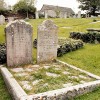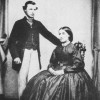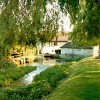Wool did not become a parish in its own right until 1844. Until then it had been a chapelry of Coombe Keynes, although those resident in Wool were granted the right to bury their own in their own churchyard as early as 1384. Parts of the early church remain but most of what we see today is the result of a Victorian rebuilding and enlargement; work undertaken by John Hicks of Dorchester between 1864 and 1866.
In the first edition of his work, The History and Antiquities of the County of Dorset, published in 1774, John Hutchins gives us a description of the earlier church: “The Chapel of Wool is a chapel of ease to Coomb-Keynes, and officiated in once a fortnight by the vicar, for which he has a salary of £5 per annum, paid by Edward Weld Esq., in lieu of all glebe and tithes. It is situated in the S. Part of the vill and consists of a chancel, body, narrow N. isle and a low embattled tower, in which are four bells. At the upper end of the N. Isle is a chapel divided from the other part by an arch, and belonging to Bindon. West of this chapel was the burial place of the Turbervilles of Woolbridge. On the wall, ‘M.T. Matthew Turberville.’ There is nothing remarkable in it, but an ancient pulpit cloth, well preserved, said to have belonged to Bindon Abbey. It is brown velvet, and on it are embroidered in gold, the twelve apostles, but it is most probable it belonged to Bindon Chapel, and was preserved when that and the house were burnt in the civil wars. The inhabitants of this chapelry maintain their own chapel and poor, and burry in the chapel yard.”
(The Pulpit cloth Hutchins refers to is actually an altar frontal. Because of its fragility it was placed with Dorset County Museum in the 19th century).
Another person of note to visit the church before the changes of 1866 was Sir Stephen Glynne (1807-1874). He was a Welsh landowner, politician and, importantly for our purposes, he was an antiquary and student of church architecture; he has left us the following description: “A small church consisting of nave and chancel, each with north aisle and north and south porch, and a western tower. The whole built of stone. There are some First Pointed portions; of which character is the arcade of the nave, having three arches with circular columns of which the capitals are moulded. The western respond has good foliage. There is a curious triple chancel arch, with light octagonal piers having no capitals. The eastern pier beyond the arcade is very large and contains a square opening now glazed. The windows of the nave are Third Pointed, chiefly square-headed. The chancel has First Pointed lancets and a Priest’s door on the south. The east window Third Pointed. On the north of the chancel is a plain continuous arch opening to the aisle or chapel, with a large wall space eastward. There is a similar arch between the aisle of the nave and that of the chancel. On the north side of the tower arch is a staircase with openings facing eastward. There is a hideous north gallery. The tower arch has fair mouldings. The tower is Third Pointed, with battlement and buttresses set away from the angles; at the south-east , a polygonal turret terminated by a pyramidal finishing. The belfry window of two lights, a slit in the second stage, and no west door. Instead of the eastern belfry window is an open quatrefoil. The porches are also Third Pointed – the outer doors having shafts and the north porch quatrefoil openings on the sides. The font is Third Pointed, the bowl octagonal, panelled with quatrefoils. There are no parapets. The nave is slated, the aisle leaded, the chancel tiled. In the churchyard are seen the odd names of Cram and Phone.”
(The references above to “First-Pointed” and “Third-Pointed” mean 13th and 15th century respectively).
It seems the church used to be at the centre of the village; due to development these days it is at the south-east end of the village but it seems that changes had begun by 1852. Hutchins editors (3rd edition published in 1861) report “There is a tradition amongst the people, that some time ago it (the church) formed the centre point in the village; and within the memory of the present generation, changes have taken place which have made it less so than formerly, some houses near the church having pulled down, and others built at a greater distance from….” In 1852 the singing gallery that had extended much further into the church was moved to a position behind the tower arch; in later developments it disappeared altogether.
On the 28th of July 1864 edition of the Dorset County Chronicle an urgent appeal was made on behalf of the church and the parishioners of Wool. It stated that the architect, Mr Hicks of Dorchester, has stated that he considers the church highly dangerous in its present condition: the roof “is fast giving way”. It was proposed to rebuild the nave and to add a new aisle at an estimated cost of £1,000.”
This was followed by a faculty dated 23rd December 1864 for “wholly to take down the same church and chancel (with the exception of the tower and portions of the north and west walls of the nave, porch and arcade) and in lieu thereof erect fit and complete upon the same site and adjacent portions of the churchyard a substantial and durable church and chancel upon a larger scale with the additions of a south aisle and vestry room and extending the chancel twelve feet ten inches into the churchyard.” The estimated cost at that time was £1,160 and John Hicks was to be the architect. The work was carried out in 1865-66, pretty much in accordance with the faculty and all of the roofs were renewed. During the rebuilding a medieval Cresset stone was found, it is a form of oil lamp with four holes for wicks.
The re-opening of the church was reported in the Dorset County Chronicle of 30th August 1866. The report mentioned the work of Mr Hicks, the architect and the builder, Mr Wellspring of Dorchester. The name of local stone mason Mr Grassby is also mentioned several times in the newspaper’s report. The report went on to cover the re-opening service and luncheon for invited guests, which took place in a tent erected in a nearby field.
In 1907 a sixth bell was added and all the bells re-hung in a new steel and iron frame; in 1970 a small chapel was added at the east end of the north aisle.



